Paper Doll
The Boo-Hoo Box: Organizing Painful Clutter
This post was originally published on May 17, 2021. It has been updated as of August 21, 2022.
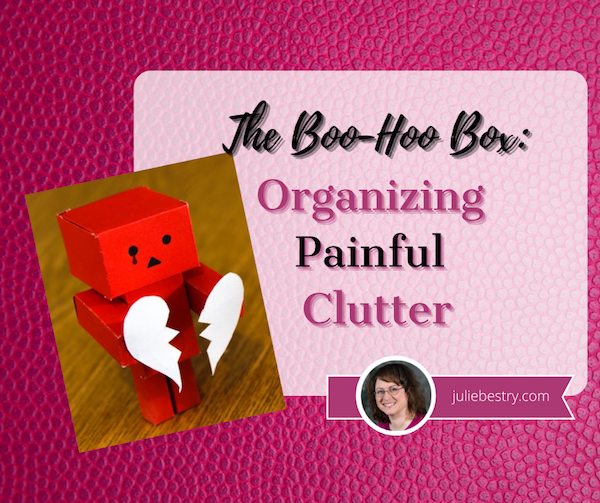
Red Amazon Danbow on Brown Wooden Surface by burak kostak from Pexels
As you read organizing blogs, it may seem as though all of the advice is the same, about reducing clutter and then organizing what remains. However, it’s important to recognize that not all clutter is the same.
CATEGORIES OF CLUTTER
Understanding the different types of clutter gives us good insight into the different reasons we keep things, but also helps develop different strategies for managing that clutter. When working with my organizing clients, we tend to identify six different kinds of clutter.
- Practical clutter — These are things that are useful, in and of themselves, like clothing, bedding, or kitchen implements. It’s not that we don’t need these things, but we generally don’t need so many (black skirts, frying pans) and we need to let go when specific items no longer suit our needs.
- Informational clutter — We keep documents and clippings, whether on paper or digitally, because we believe the information is valuable. The problem is that we rarely go back to consider how valuable something is now vs. when we acquired it, and we tend not to think about whether it might be better to eliminate outdated information, digitize it, or access the information anew via the internet to reduce the bulk.
- Identity clutter — Sometimes, the clutter we keep is an excess of items that we feel help define us. Our clutter may not be useful (in a practical sense) but we perceive it as useful for defining who we are or who we wish to be seen as. Our clutter might say, “I’m the kind of person who runs marathons [or wins spelling bees or bakes from scratch].”
- Aspirational clutter — This type of clutter accounts for all of the items in your space which support hobbies you tell yourself that you are going to take up, but never really do. Whether you are saving a closet full of fancy papers and Cricut gadgets for the day when you finally decide to become a scrapbooker or amass shelves of books on the topic of How To [train championship Greyhounds, write a novel, become a successful crypo-tocurrency miner], there comes a point when you’ve got to recognize that you have an excess of items supporting a life you don’t really lead.
- Nostalgic clutter — Nostalgia is defined as “a sentimental longing or wistful affection for the past, typically for a period or place with happy personal associations.” Obviously, life is made better by the things that truly remind us of happy (or happier) times, but an excess of nostalgic emblems of our past can fill up our homes in the present and prevent us from having space in our lives to make a future. Sometimes, we just have to take photos of those ancient macaroni art projects and discard the originals, letting them crumble in peace.
An excess of nostalgic emblems of our past can fill up our homes in the present and prevent us from having space in our lives to make a future. Click To Tweet - Painful or sad clutter — This category encompasses things that remind us of bad times or bad people.

Break-Up Photo by Kelly Sikkema on Unsplash
Today, we’re going to look at that final category and how to make letting go easier.
It may seem odd that anyone would hold onto things that make them unhappy. Sometimes, they’re keeping things that are unpleasant but necessary to maintain (for legal or other reasons), but far more often, we professional organizers find clients keeping things that just plain make them feel bad.
KNOW WHEN TO ELIMINATE PAINFUL CLUTTER
Early in my career, I worked with a client who was trying hard to regain control of her life after a variety of disappointments and challenges. We’d made it through her closets, cabinets, and practical storage areas and were working through her home office easily until we encountered personal papers. At that point, we hit a wall.
This is why most professional organizers will encourage you to start with practical items and those with no sentimental attachment; it’s important to build up decluttering and decision-making skills first before attempting to let go of possessions that are fraught with the weight of personal history. For this client, the emotional clutter took the form of a series of letters written by her mother.
These letters were unpleasant, unkind, and to my eye (and according to the client) filled with claims that were patently untrue. My client had done a remarkable job developing emotional strength and stamina to reject emotional abuse from earlier in her life. Intellectually, she wanted to let these items go. Emotionally, she could not bring herself to do it.
It’s not my role as an organizer to make decisions for clients; rather, I present my expertise and advice and try to support them in the ways they most need in order to reach their stated goals.
Getting Ready to Let Go
So, first, we talked about how and when she “used” the letters. She noted that she used to read the letters far too often, in effect abusing herself by becoming a sort of Groundhog Day postal carrier, re-delivering the anger and unkindness to herself. She felt she’d “gotten better” in recent times, only looking at them when her self-esteem was at its lowest. Of course, that’s when they could do the most damage!
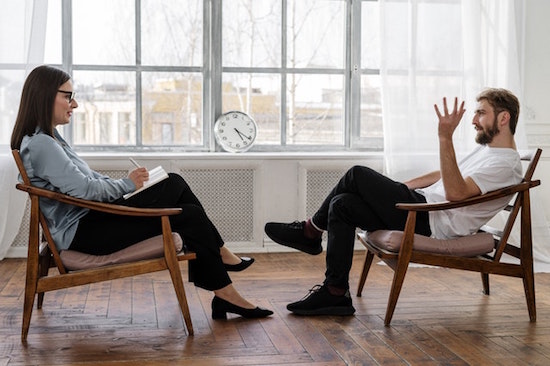
Therapy Photo by cottonbro from Pexels
Second, I encouraged her to discuss the letters with a therapist. Although my client has shared much of her prior history in counseling, she had not shared the specific content: the ugly words, threats, and heart-wrenching claims. After several sessions, my client felt relieved because a trained mental health professional was able to disabuse her of the idea that the letters held any more truth than a scary Stephen King novel.
Finally, we talked together about why she thought she was keeping the letters. (She touched on this in therapy, but we found some different angles.)
It’s very common that when we have a tangible reminder that someone has hurt us, we hold on to it as proof. Somewhere deep inside us, we may feel that letting go of the proof is absolving the person of responsibility for what they’ve done.
It’s not true.
Letting go of your college boyfriend’s tacky breakup letter won’t absolve him of the pain he caused you. But it will set you free from the cycle of pain you experience every time you re-encounter it when flipping through your yearbook or sorting through mementos.
Letting go of your college boyfriend's tacky breakup letter won't absolve him of the pain he caused you. But it will set you free from the cycle of pain you experience every time you re-encounter it. Click To TweetIf you have painful clutter, once you’ve talked through the underlying issues with a licensed mental health professional, it may help you to then recite a quote variously attributed to everyone from St. Augustine to Carrie Fisher:
“Resentment is like taking poison and waiting for the other person to die.”
Be Kind To Yourself
Not all of the painful clutter in our lives comes from others. Sometimes, we hold onto things that reflect pain that we’ve caused ourselves. I’ve had clients who keep “fat photos,” pictures of themselves in bathing suits when they were significantly less healthy than they are now, in places where they’ll come across them fairly often — in their underwear drawers, on the walls of their closets, under a silly magnet pinned to the refrigerator door, etc.
Come on now. That’s just bullying yourself. Yes, some people need the stick rather than the carrot approach to be motivated, but it’s important to avail yourself of healthy motivators.
Similarly, people often hold onto what they view as examples of their failures. These often come in the form of messages from others who (generally) mean no ill will, but which individuals use to beat themselves up.
For example, I’ve worked with clients in their fifties who saved college rejection letters and failed tests. In some situations, these kinds of things can have potential to motivate; if you post the 37% you got on your algebra quiz above your desk, it may help you push forward to do your homework, work with a tutor, and attend office hours, but if all it does is sour you on math (or if you’ve been out of school for decades and never have to take another math class again), then OMG, free yourself!
Not everyone has to be good at math. As Paper Mommy often says, “Someone has to make the struedel!”
Not everyone has to be good at math. As @PaperMommy often says: Someone has to make the struedel! Click To TweetSimilarly, if you’re keeping rejection letters for your novel so you can make them into wallpaper, or show them off as a badge of honor once you make good, that’s cool. But if, instead of motivating you, they just make you sad, then they’re clutter. It’s time to let go. Shred them. Trash them with the wet coffee grounds, cat litter, and dirty diapers. Burn them.
[Note: the above advice is designed to help you let go of the sad kind of painful clutter. However, if you have been the victim of domestic violence, stalking, or workplace or online harassment, it’s important to be able to document the behavior, especially if it escalates, for legal purposes.]
HIDE PAINFUL CLUTTER
Fans of The Gilmore Girls may recall Lorelai’s two pieces of sage advice to her daughter after Rory and her first love, Dean, broke up.
First? “Wallow!”
From an organizing perspective, however, a more important piece of guidance is knowing when to create The Box. In the show, Lorelai helped Rory gather up every reminder of her precious, heart-wrenching three-month relationship with Dean (complete with the box of corn starch Rory accidentally shoplifted after Dean surprised her with her first kiss). Then they put it all in a box. A Dean Box.
Rory begged her to take it all “far, far away from the house” and Lorelai promised that, like any good mafia hit victim, “it sleeps with the fishes.” Of course, as Rory eventually learned, her mom actually just hid the box in the back of the closet, wisely knowing that sometimes, our painful clutter isn’t always painful forever, and it’s not always even clutter, with the passage of time. Sometimes it can become nostalgia.
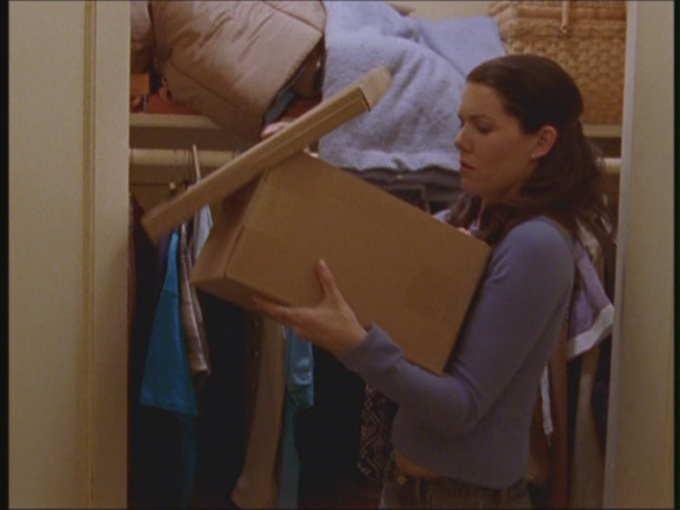
You may have your own version of the Dean Box. (Even Lorelai had a Max Box, reminders of the man who proposed with a thousand yellow daisies.) I often call it the Boo-Hoo Box, or the Bad Boyfriend Box. Sometimes it starts with reminiscences from one heartbreak and it becomes a repository for all the heartbreak you’ve experienced over time. That’s fine, as long as you stick to one box — the point is to lessen the clutter in your space!
Baby Steps for Hiding Painful Clutter
Use a non-descript container for the Boo-Hoo Box. If you use a pretty hatbox or a container in a designer color, then you’ll never be able to use that container and see anything but heartache. Opt for something quotidian and universal, like a used Amazon box or a classic Bankers Box.
Label the box in a low-key way, especially if you don’t want people poking around. “1997 Tax Prep” is a label that won’t encourage anyone to go spelunking. You’ll know what the box contains, unless you’re one of the rare people gifted with people able to always and completely forget about the Boo-Hoo box. (If you are, then once you come across the box after a long time, you’ll be in a much better position to review the contents and downsize or even eliminate it.)
Store the box where you won’t have to see it all the time. The back of a closet is the best place to hide heartache you’re not ready to toss. (If feng shui matters to you, try not to store the box in the part of the bagua related to romance or family, or whatever the contained items relate to.)
Rename paper file folder tabs if being reminded of the content stirs up too much emotion. One of my clients was going through a divorce. He needed to keep a variety of documents at easy reach, sometimes even on his desk, but didn’t want to be reminded (or have his kids reminded, when they walked by the desk). Yes, obviously everyone knew there was a divorce, but he didn’t need to keep rubbing salt in the wound. We labeled the file “Dallas” because Dallas and divorce both begin with D and because nothing about Dallas duplicated anything he was already working on. Give yourself some emotional distance from the contents when you can’t create physical distance.
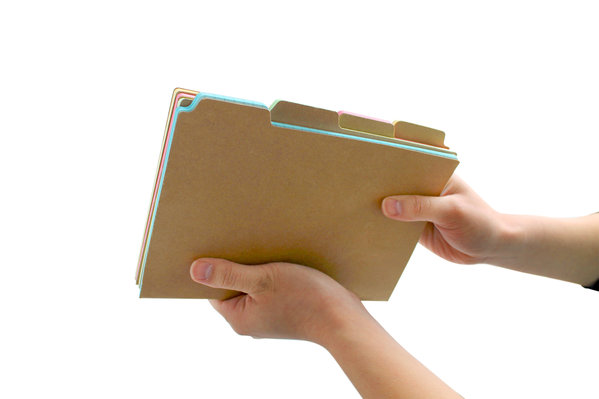
Create digital Boo-Hoo boxes for your non-tangible painful clutter:
- To keep but hide certain unhappy-making emails, create a separate subfolder and manually move the email out of your inbox. [Note: If you’re maintaining email from a stalker, an estranged family member, or someone whose message you’d otherwise like to avoid, use the Rules function of your email platform (Gmail, Outlook, Apple Mail) to automate moving all mail arriving from a sender to a specific subfolder.
- If you have painful documents on your computer, it’s important to avoid stumbling upon them. Create a folder that serves as a digital Boo-Hoo Box and put it inside another folder, one where the hierarchy makes sense. A folder called “Yucky Stuff” will alphabetically sort near the bottom of a “Personal Stuff” folder on your computer, and is vague enough that it won’t immediately call to mind the thing that might set off tears.
- On your phone, photos of you and a loved one that are too painful to look at right now could be marked as “hidden” and will be sent to a hidden album to which you need to navigate, rather than randomly showing up in your camera roll. Remember, the purpose of hiding is not security, but just to protect your heart.
- If your painful clutter comes by way of social media, remember that you have options. Whether your former BFF uninvited you to a wedding, you’re on the outs with a family member, or you don’t want your ex to know how much it hurts to see them moving on, learn the tools that let you play it cool. On Twitter, you can mute someone without unfollowing; on Facebook, you can unfollow without unfriending; on Instagram, mute without unfollowing.
Send your heartbreak on vacation. Sometimes, you need to get painful clutter completely out of your space until you are in the right frame of mind to think about it. One stellar solution is to take your Boo-Hoo Box to a close friend’s home — OK, probably your best friend’s home — and let them babysit it in the back of their closet for six weeks or six months or six years.
Obviously, you don’t want to turn your clutter into theirs, which is why you want to limit this to one reasonably-sized box. Seal it more securely than you would if it were in your own home, especially if your friend has tiny humans, and label it with something that has your return address on it in case something unforeseen happens.
If the contents of the Boo-Hoo Box are sensitive, something that you could not bear to have seen by your BFF or her snooping mother-in-law or have displayed on social media, open a safe deposit box at your bank and secure it there. By the time your box is up for renewal in a year, you’ll have had time to consider the contents with fresh eyes, and hopefully, a refreshed spirit.
EVENTUALLY…
As Lorelai Gilmore wisely knew, heartbreak doesn’t last forever. Eventually (hopefully), it’s the ending of some love stories that creates the poignancy that makes the whole romance worth revisiting, whether after months, years, or decades. (This likely feels more true of anyone’s first lost love than a recent one.)
Other kinds of sadness comes from loss, from cruelty, from embarrassment, and from a variety of sources at which we’d like to stick out our tongues. There’s no timetable for getting ready to review or to eliminate any of these items. But it’s healthier and easier to heal with we’re not confronted with reminders of our pain every day.
The more we can downsize, repackage, and yes — if necessary — hide painful clutter, the more quickly we can regain our emotional strength and resilience.
Paper Doll, Media Darling — or Expert Organizing Advice and How to Get It

Who are the experts in your life?
We turn to doctors, lawyers, accountants, professional organizers… In my family, when I need advice about cooking or want to know if a booboo requires medical attention or is just one of those weird things, we refer to it as “opening the Mommy Encyclopedia” and I call Paper Mommy.
Sometimes, I get to be expert.
Real Simple and Photographs
 Because I’m a professional organizer, I often get asked to share my expertise with the media. Sometimes, it’s an organizing or productivity topic that’s right in my wheelhouse. Other times, I need to do a little research, confer with colleagues, or make a referral to someone better-versed in the topic.
Because I’m a professional organizer, I often get asked to share my expertise with the media. Sometimes, it’s an organizing or productivity topic that’s right in my wheelhouse. Other times, I need to do a little research, confer with colleagues, or make a referral to someone better-versed in the topic.
Back in January, Senior Editor Rachel Sylvester interviewed me about organizing and managing family photographs for the May 2021 issue of Real Simple. 
Longtime readers of this blog know that while brevity may be the soul of wit, longwindedness is the backbone of Paper Doll. I had a lot to say about organizing family photos, like:
- how and where to locate all the print and digital copies
- how to gather all your photos together so you can see the big picture (no pun intended)
- how to automate your backup (because you know I’m all about the belt-and-suspenders approach, using a local external backup drive and a backup in the cloud, like Backblaze)
- how to identify and eliminate duplicates
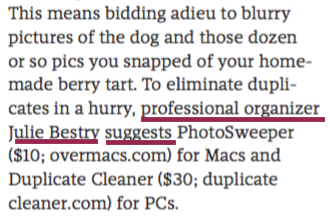
- how to eliminate fussy backgrounds or jerky ex-boyfriends with apps like Remove
or Slazzer, or the built-in background remover in Canva Pro. (Sadly, these apps only remove jerky ex-boyfriends from photos, not from your memory or personal history.)
Of course, organizing your photos only starts with these steps. Beyond the basics, you may want photo organizing and editing software, as well as a wide-variety of ever-changing photo storage options beyond your own Dropbox or local drives.
For example, while longtime free, effective June 1, 2021, Google Photos is capping free photo storage at 15 GB; after that, you’ll need a Google One account for $1.99/month for 100 GB. Other solutions include:
Apple iCloud Photo Library – Built into iOS devices, it’s 5GB for free, $0.99/month for 50GB, $3/month for 200GB, or $10/month for 2TB storage.
Forever – With a wide variety of storage options from 2GB (free) to 10GB up to 1TB, ranging from $13.30-$489.30/month. (Obviously, those mega-dollars are for professional-level storage.)
Flickr – Store one thousand photos for free, then consider $7/month or $60/year for unlimited storage.
Photobucket – Selections range from Beginner level for $6/month for 25GB, Intermediate for $8/month for 250GB, or Expert level at $13/month unlimited storage. (Note: You can only store uncompressed photos at the Expert level.)
When I work with clients, I bring my expertise on the first set of topics. We work together to gather photos (and slides – there are always slides!), plow through to eliminate most of the seventy-three shots of the front lawn of the new house the day they moved in (and yes, we eliminate some jerky boyfriend photos, too), and discuss storage options.
If clients want to digitize photos, we discuss their DIY options, but it’s not a service I provide. (You really can’t be an expert at everything.) Instead, I often send clients to my Atlanta-based colleague Jiffy Page of Pixorium, and I can tell you that her people treat my client photos with as much respect as (and often more than) families give their own old snapshots!
If clients have more complicated photo organizing needs, or they are far off from my service area and the project isn’t suitable for my virtual services, I recommend my colleagues. You can find superior photo organizers in two places:
The National Association of Professional Organizers – Use the geographic search from your zip code to find service providers who specialize in photo organizing. (After doing the zip code radius search, select “photography/memorabilia/collections” from the Residential Organizing and Productivity Categories drop-down.)
The Photo Managers (previously, the Association of Personal Photo Organizers, or APPO) – Search geographically and by a wide variety of photo-related services, including related areas, like backup solutions, data recovery, photo restoration, family history research, and more.
When I need advice on a photo organizing topic, I have my own experts to whom I turn, including:
Andi Willis of Good Life Photo Solutions in Georgia
Hazel Thornton of Organized For Life in New Mexico
Jill Yesko of Discover Organizing in Pennsylvania
Isabelle Dervaux Photo Organizer and Visual Storyteller in New York
And for those who want a grounding in photo organizing concepts for DIY projects, I recommend the book written by Cathi Nelson, the founder of The Photo Managers, Photo Organizing Made Easy: Going from Overwhelmed to Overjoyed.
Paper Doll Recaps the NAPO2021 Virtual Conference
Each year, professional organizers and productivity specialists look forward to the National Association of Productivity and Organizing Professionals‘ Annual Conference with glee. We come from around the world for a handful of days to learn and laugh, dine and delight. So, you can imagine that like everyone else in March 2020, we were disappointed (though, due to circumstances, also relieved) when last year’s conference in Orlando was canceled.
The 2021 conference had been set to be in Long Beach, California, but as the COVID pandemic stretched on, it soon became obvious that those plans, too, would be cancelled, and efforts began in earnest to develop a virtual conference.
We all wondered whether a “real” conference would be possible, virtually. While Zoom and various other virtual platforms have grown in popularity, children have attended school online, and businesses have conducted work without conference rooms (or, sigh, birthday cake in break rooms), how could a virtual rendition of our conference deliver?
Very well, it seems, is the answer. Paper Doll thanks you in advance for indulging me in this post, which, like every year, I use to regale you with the true low-down on NAPO Conference. Whether you normally tune in here for organizing tips and are merely curious, or you are an organizing professional who missed this year’s experience, I hope you’ll enjoy coming along on this somewhat atypical conference recap.
ORGANIZING THE PLATFORMS
How would the virtual experience compare to our real-world experiences, we wondered?
Well, obviously there were no airports or hotels*…and sadly, no grand, dining experiences. There were also no committee meetings, as it was wisely realized that while at home, many of us would already be tempted by distractions of families, households, clients, and anyone else whom we’d be able to avoid if we were, in actuality, several time zones away. Rather than trying to juggle committee meetings on top of everything else, NAPO wisely limited the event types and interspersed them with online networking time so that we could get more of the facsimile of what we’d most miss.
* I should note, strictly speaking, that some professional organizers did choose to get hotel rooms. Away from the madding crowds, or at least their tiny humans, a number of wise professionals took the advice they’d have given their own clients, and carved out time and space just to focus on the conference. And a few hardy adventurers rented hotel rooms to socialize with already-vaccinated colleagues from their NAPO chapters and “attend” parts of conference together.
We also, sadly, had no Expo at which to sample the wares of various organizing, productivity, and technology companies. Over the past few years, our NAPO Expo has gotten smaller, as it’s hard for companies (especially the nifty, but tiny, startups) to shlep across the country for the bit of time we can carve out from education and networking to look at products. Hopefully, the same kind of wisdom that devised our brilliant virtual conference will find a way to satisfy our hunger for Expo displays of intriguing new products.
Wondering how it all worked? Well, we had more than one platform. We used a company called Hubb, which gave us this virtual lobby. We could click on the rooms in the video game-style layout below (or use the left-side menu) to access information about the individual sessions, the speakers, and the other attendees. Instead of a hotel help desk (wo)manned by our association management team, there was a detailed FAQ document with ways to reach out, virtually, to the team.
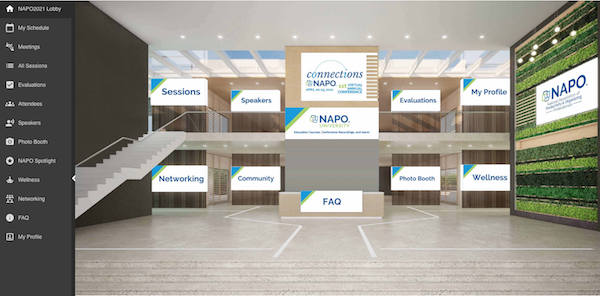
In lieu of inviting one another for walks in the fresh air or taking a few (way too) early yoga classes, NAPO found members willing to create “wellness” videos: a desk break, guided meditations, and yes, even a few yoga video sessions.
There was a photo booth, though we could only take selfies to display in a gallery. (Let’s hope someone figures out technology that let’s us squish our heads more closely together!) Instead of personalized badges with our stream of ribbons telling whether we hold leadership positions, to which chapters we belong, and what our “extracurriculars” might be, we had a profile section for listing all our nitty-gritty details. Some left it blank, others included their entire resumes. And some of us, relishing the opportunity to mix business with pleasure, got a little silly.
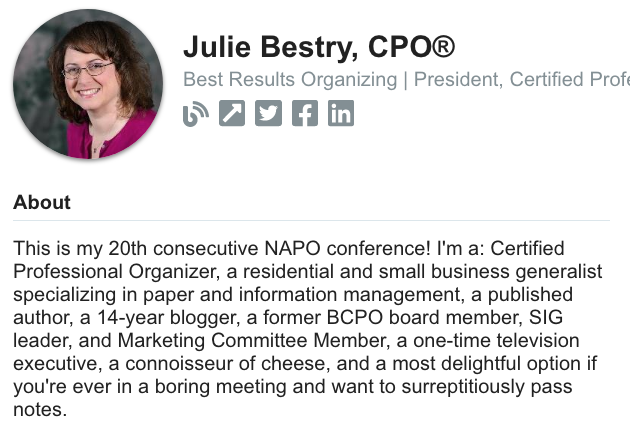
To “attend” a particular session, there were a few steps. Instead of walking to the session room, you had to add a session from the master list to your personalized schedule ahead of time. (General sessions to which all members are invited already appeared on everyone’s individualized calendars.)
If you wanted to attend a concurrent educational session, you’d click on it in your calendar. The ensuing page would include details about the session, an embedded pre-recorded video, and a chat box. At first, I think we were all slightly dismayed to learn that all the sessions were pre-recorded, but it actually turned out to be a boon for the educational experience.
In a live conference session, both the speaker and the attendees can feed off one another’s energy, but anyone who has lived on Zoom in the past year knows that’s not how virtual works. However, simultaneous with the video, the attendees could interact with the speaker and with one another via chat, leading to lively riffs on the content and (especially during technology sessions) a deeper understanding of the material.
No platform is perfect, of course. You could pop out the chat box to have it run parallel to the tab with the video, but if you wanted to enlarge the video, you had to make it full-screen, eclipsing the chat screen (unless you had two monitors or wanted to use a second device). Still, we were all impressed by the ways in which this recorded+live interaction amplified the learning experience.
To attend general sessions, the experience was mostly the same, although the videos were a combination of live and pre-recorded. However, for interactive sessions, our personalized calendar event pages sent us to Zoom sessions. (In 2021, there is no avoiding Zoom!)
Finally, for networking, our personalized calendar links would take us to our second platform (or third, if you count Zoom), Remo. Luckily, I’d used Remo last month for the Time Blocking and Task Management Virtual Summit, so I feel like I had a bit of a head start.
Basically, Remo’s platform is like the overhead view of a wedding seating chart, with “tables” designated for two, four, or six people, and with some events, there are added couches for a karaoke lounge kind of feel. Depending on the activity, tables were either themed or just numbered.
From the overhead view, you could spot a person’s profile photo, think, “Oh, I want to chat with her!” and double-click on that table to be taken there. Once “at” the table, you were added to a Zoom-like video chat. The shot below shows the stragglers as we shut down the conference.
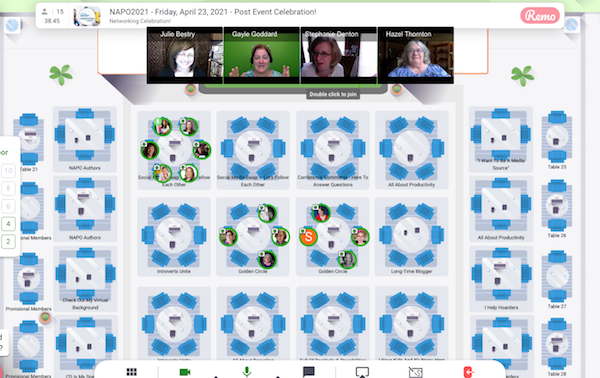
One small click on an icon on the lower left and all of the video squares enlarged to fill the screen. Another click on someone’s photo let you send them a message. And a small “elevator button” panel on the left let you go to higher level “floors,” identical, but less sparsely crowded, during the high-traffic times when it was almost impossible to find a “seat” in the room.
(As a few of us learned, the upper floors were also a great place to hide out for a moment, get a breather, and fix our hair while looking in the camera before rejoining the crowded tables.)
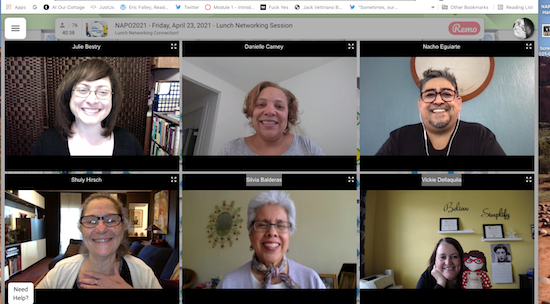
Because networking is informal, it had that lovely cocktail party-esque flow of old friends and new. Conversation ranged from how to use the platform to our thoughts on the sessions we’d just attended, and at one late afternoon session, to our reaction to breaking national news. Just as with a live-and-in-person conference, virtual networking gave novices a chance to meet and chat with veterans on a level playing field.
And although this was my 20th consecutive NAPO conference, I got to completely fan-girl when Stephanie Culp, one of NAPO’s original founders (way back in 1985, the year I started college) sat down at a two-top table with me. Hers was the first organizing book I’d ever purchased, a decade before I ever became a professional organizer!

I’ll admit, I felt pretty special that although we’d never actually met, she’d chosen to chat with me..until I found out the system just plopped her down at my table when she entered Remo. But hey, she decided to stay and chat for half an hour, so I’m going to take that as a career win!
EDUCATION
One of the main purposes of the NAPO conference is education, to help us serve our clients and to start, build, and grow our own businesses. To that end, at the beginner, intermediate, and advanced levels, NAPO conference presented programming in five educational tracks during each of the six concurrent sessions over three days of our conference. (Yes, I know, I usually promise you that there’ll be no math in these posts. Sorry.)
Organizing & Productivity Track
These kinds of sessions are the bread-and-butter classes, where we learn techniques and strategies in a variety of specialized organizing and productivity fields.
Moving On Up: Grow and Add Value with Moving Services presented by Gayle Goddard, CPO® and Ann Zanon, CPO®
Right Sizing for Tiny Living – Connecting To What Matters Most presented by Tricia Sinon Murray
Focus Your Profits on Photo Organizing presented by Jill Yesko, CPO®, CPPO
Grow Your Business: Expand Into Estate Clearing presented by Candi Ruppert, CPO®
Student Organizing – The What, Why and Is It For You? presented by Amanda Lecaude
Beyond Organizing, Office Design and Space Planning presented by June Carter, CPO®
Mind & Behavior Track
As I often say, professional organizing is not about the stuff, it’s about the person who owns the stuff. To that end, we are always offered classes that consider the psychological, neurological, and emotional challenges our clients face.
Managing Difficult Clients (and Situations) with Clear Boundaries presented by Lauren Mang
This is Scary: Embracing Discomfort to Help You and Your Clients Succeed presented by Sara Skillen, CPO®
Organizing the Invisible: Women, ADHD, and Emotional Labor presented by Regina Lark, CPO®
The Hierarchy of Healing Your Home presented by Dorena Kohrs
Connecting the Dots: Organizing Clients with ADHD by Working with Executive Functions presented by Erin Morper
Although I had not intended to follow a particular track, three of the six sessions I attended were in this Mind & Behavior track, and I was deeply impressed. I can see how much of what I learned will be fodder for discussion with my clients.
Sara Skillen shared some profound wisdom about embracing fear as we push past our comfort zone, and her comment that “Learning to tolerate discomfort lessens its power over you” has been echoing in my head for days.
Sara Skillen shared some profound wisdom about embracing fear as we push past our comfort zone. Her comment that 'Learning to tolerate discomfort lessens its power over you' has been echoing in my head for days. Click To TweetSara’s presentation was guided by her book, Organizing and Big Scary Goals: Working With Discomfort and Doubt to Create Real Life Order.
Paper Doll Organizes the Internet: 5 Tools for When the Web Is Broken
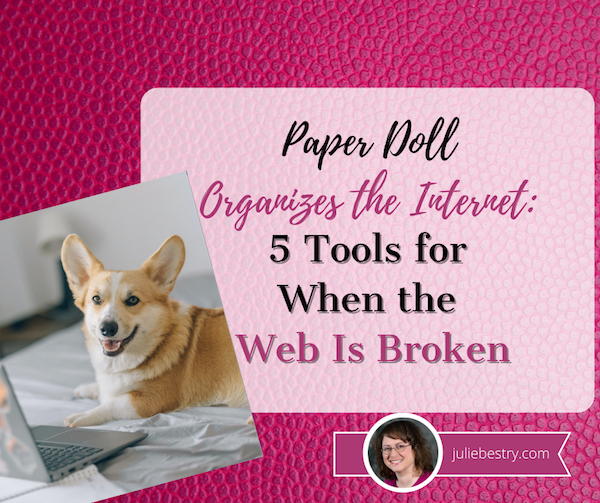
Photo of doggy using the web by Nataliya Vaitkevich from Pexels
Have you ever tried to access a web site but nothing happens? At least nothing good? You may fiddle around, clicking the site over and over. Sometimes, you manually retype the link even though you know what you clicked should work.
Instead of getting progressively more agitated, there are a few different things you can do to maximize your efforts and use your time efficiently.
MAKE SURE THE PROBLEM ISN’T AT YOUR END
Verify that you are connected to the internet. It may seem obvious, but sometimes you’ll be working along and then all of a sudden your router decides to have a brain freeze and sever your WiFi. Less often, your internet provider might have hiccup. It can last a few seconds or (too) many minutes.
I have two router networks, a main one, and a secondary one that I could (should?) probably delete. Sometimes, when my primary router goes down, my WiFi kicks over to the secondary one, which is iffy. It can be perfect or wonky, depending on how it feels that day (much like my hair). Usually, I won’t have any idea this has happened unless I check the WiFi drop-down from my Mac’s menu bar. (Yes, I have a lot of neighbors, and no, I don’t borrow their WiFi.)
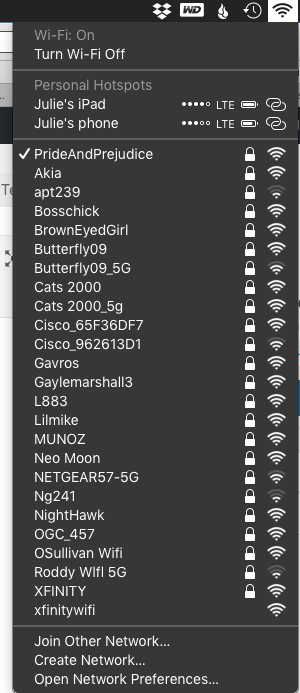
If your connection to the internet isn’t the problem, it’s time to check your tools.
Try a different browser or a different device. In general, any modern website should work on any browser. However, if your operating system is older, such that you can’t upgrade your browser, some sites may refuse to render properly, or even at all. If you’re using Safari and a site won’t show up, try using Chrome, Firefox, or some other browser, upgraded as much as possible, to see if the site works there.
If the site won’t open on your computer, your next step is to try to pull it up on a mobile device, like your phone or tablet. There, you get two options. First, you get to check to see if it’s a device-specific problem. You can also turn off WiFi on the phone and check to see if you can reach the site via your cellular data.
Sometimes, for no clear reason your computer or WiFi just doesn’t like a site anymore. There’s a solution!
Clear your cache and cookies for that site. Most people don’t want to clear their cache or cookies because then they’ll have to log back into sites for which they’ve been semi-permanently logged in for eons. But you can just clear your cache and cookies for specific sites.
Lifewire has an excellent article on how to clear cookies for one specific site for Chrome, Firefox, Safari, Internet Explorer, and Opera, the browsers you’re most likely using. For other browsers or platforms, enter “clear cookies for one site” along with the name of your platform/browser, like iOS/Safari, or Android/Chrome.
USE TWITTER INSTEAD OF GOOGLE
Check Twitter. Whatever else you think of Twitter’s role as a social network, it’s probably the fastest way to get a real-time update if something somewhere has gone awry. If you can’t connect to your bank or Disney+ or Instagram, try just typing the site into the search box. If it’s been down for more than a moment, you’ll likely see a crowdsourced timeline of complaints about the problem.
Of course, this is not the best solution when Twitter is the site that’s down, as happened this weekend.
USE A SITE STATUS SERVICE TO GET REAL-TIME REPORTS
The following sites are great for those times when you can’t tell if your WiFi is flaky or your favorite site has been hit with a DDOS attack. It’s also a quick way to check whether your own web site is down after you’ve done some updates and aren’t sure you’ve cleared your cache properly or done those other mysterious things your webmaster told you to do.
I should note that one thing all of these sites have in common is that they are not going to win any awards for aesthetics. Most were built anywhere from 10 to 20 years ago and have a decidedly early 21st-century design style. I’m not sure why nobody has created an attractive status reporting site that can still (sigh) sell advertising unobtrusively, but until that happens, these sites offer quick updates so you know whether to wait a minute or move on to some other task.
Also, these sites are free (advertising notwithstanding) and don’t require you to create an account.
Down For Everyone Or Just Me?
Down for Everyone Or Just Me? is the best known and most classic of the site status services. Visually, it is as simple as you could want. Just enter the URL of the site you’re trying to reach, Mad Libs-style, and Down For Everyone will tell you whether your site is up or down within five seconds. Easy-peasy.

Below the search search section, there are two columns of plain-text site names grouped into categories: online grocery stores, travel Sites, e-commerce sites, financial companies, dating sites, etc. So, if you think that maybe you’ve somehow been mistyping Trader Joe’s URL and that perhaps you missed a silent 3, you can click on those popular links to speed a search instead of typing.
Down for Everyone Or Just Me is fast, and has an uncluttered interface. In recent years, they’ve added one small ad on the search page, but otherwise, there’s little to pester a user.
Also, for a nice shortcut, if you’re checking from your phone and haven’t previously bookmarked it, just type IsUp.me. (While it’s not grammatically correct, with only seven characters counting the dot, the site couldn’t be easier to locate.)
Down for Everyone isn’t ideal under all circumstances, though. It gives you a quick thumbs up or down, but you get no indication of whether other users have reported the same problem, or whether there’s a regional component. (Granted, these things may or may not interest you.) But it’s a quick-and-dirty status indicator if you just want to know whether to keep clicking or go make a sandwich.
Down Detector
Down Detector works much like Down for Everyone or Just Me, but has some attractive bonuses. First, you don’t have to type the entire URL into the search box; you can often just type the site name. (For example, type “Netflix” instead of “https://Netflix.com.”)
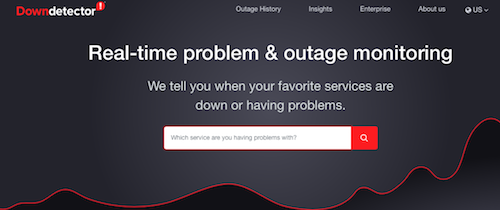
Under the search box, there are also three columns of popular services (social media sites, internet suppliers, banks, online games, etc.), with their names, logos, and a graph of their recent uptime performance. These boxes serve as shortcuts for getting real-time status reports on the most popular sites.
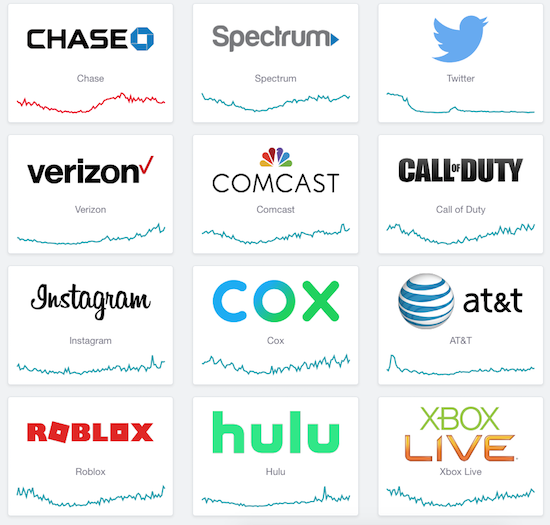
Type a URL or select a pre-existing box; the resulting page will give you a chart of recent outage reports,

a chance to report an outage at your end, and a map of locations where there’s currently an outage.
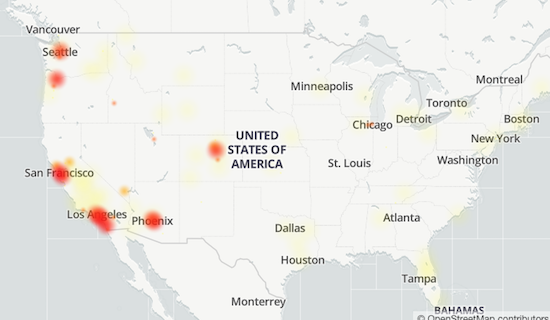
Down Detector does have some small drawbacks. It’s advertising-supported, so the search page has ads both between the search box and the cheat sheet columns of services and on the right side, and the results pages are fairly cluttered with ads.
It’s also slightly inconvenient if you want to see a heat map of the current outages, as you have to click on a faux map on the results page to be taken to yet another results page just for the map.
Finally, both the general results page and the map page have Facebook-like comments made by others, some of which are expressed in unpleasant ways. As with most social media, it’s not always for the faint of heart.
Is It Down Right Now?
Is It Down Right Now?, like the others of its ilk, offers you the ability to check a specific site, or to view the status of popular services like Netflix, Facebook, YouTube, and many more.
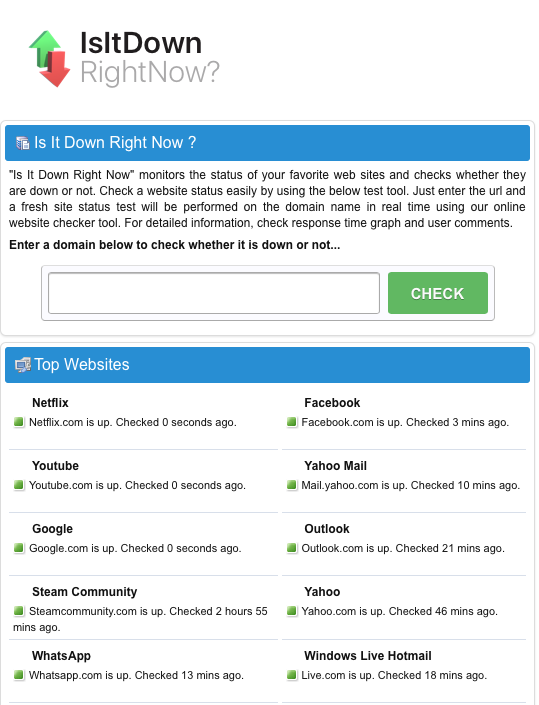
One advantage of Is It Down Right Now? is that there’s a javascript Website Status Checker bookmarklet, similar to the Evernote web clipper or Pinterest pin button you may already use. You just click and drag the icon to your browser’s toolbar, and you never even have to go to the website. Anytime you want to check the status of a site, just click on the bookmarklet on your toolbar, and you’re good to go.
Is It Down Right Now? also shows a list of the most recently down and most recently checked sites.
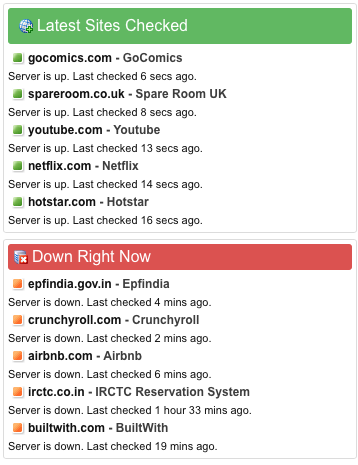
On the results page, whether a site is up or down, you’ll get to see a screen shot of what it should like when it’s working, as well as a status report showing either that it’s up or how long it’s been down, and a multi-week chart of the status history.
The search page is streamlined (with just two columns) and has just two, fairly unobtrusive, ads. However, the results page is a bit of a hot mess, with ads and Facebook comments interspersed with essential status information.
While there’s a nifty troubleshooting section, explaining how to deal with potential browser and DNS problems reaching a site, it’s hidden away on the results page. (It’s also a bit out-of-date, referring to 3G when most of us are on the precipice of using 5G.)
Outage Report
Outage Report isn’t your typical status report site. You can’t search to see if any random website is up or down. Rather, the front page lists companies with recent reports of outages, along with squiggly little graphs representing the timing of the problems.
However, the site does have a list of international and U.S. companies it monitors. If you want to know if Outage Report tracks that site, just type part of the site’s name and you’ll get a real-time filter. (Type “time” and you’ll get FaceTime, New York Times, Showtime, TV Time, Time-Warner Cable, and Lifetime. By the time you add an S to the end, it’ll have filtered out all but the New York Times outage map.)
When you click on a site name, Outage Report not only tells you what’s going on at a site, but gives you a graphic representation of the history of the site being down and tells how many reports of problems have come in during a recent period. For those who like graphics to see what’s what, this site provides some goodies.
However, I’ve been a little disappointed by how ads have taken over the flow of the site. For example, on May 19, 2017, Twitter suffered a denial of service attack. Afterward, I was able to get this quick screen shot indicating anything I could possibly want to know about the DDOS attack and uptime history prior to the attack.
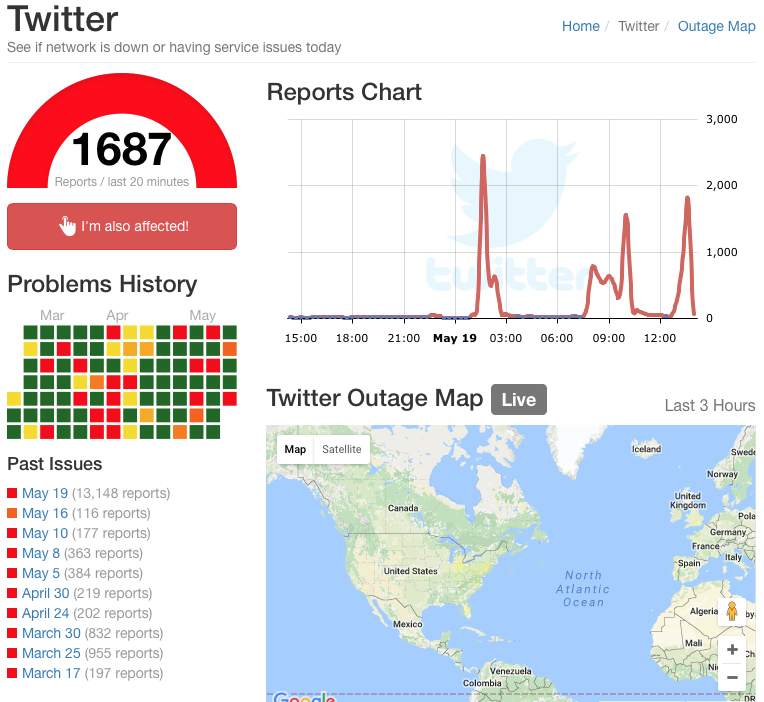
However, nowadays, Outage Report has interspersed ads such that there’s no tight, ad-free grouping of information and the long-term periodic reporting of issues has been eliminated.
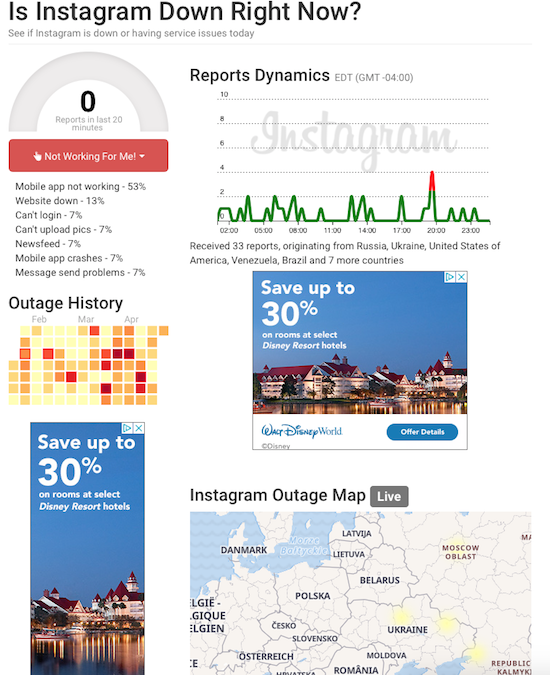
The results page is overwhelmed by ads, as well as on-site comments and ported-in tweets. However, the site does a great job of telling you where (in terms of countries or regions) particular outages exist, so if you work with clients abroad, you might find this a useful auxiliary tool.
Google Workspace Status Dashboard
If you live and work in the Google environment, you may be less concerned about a social media or banking site going down and more about whether you can get to your life-giving Google Doc, Sheet, Slide, calendar or Gmail. Last Monday morning, for example, millions of users were up in arms over Google Docs being inaccessible.
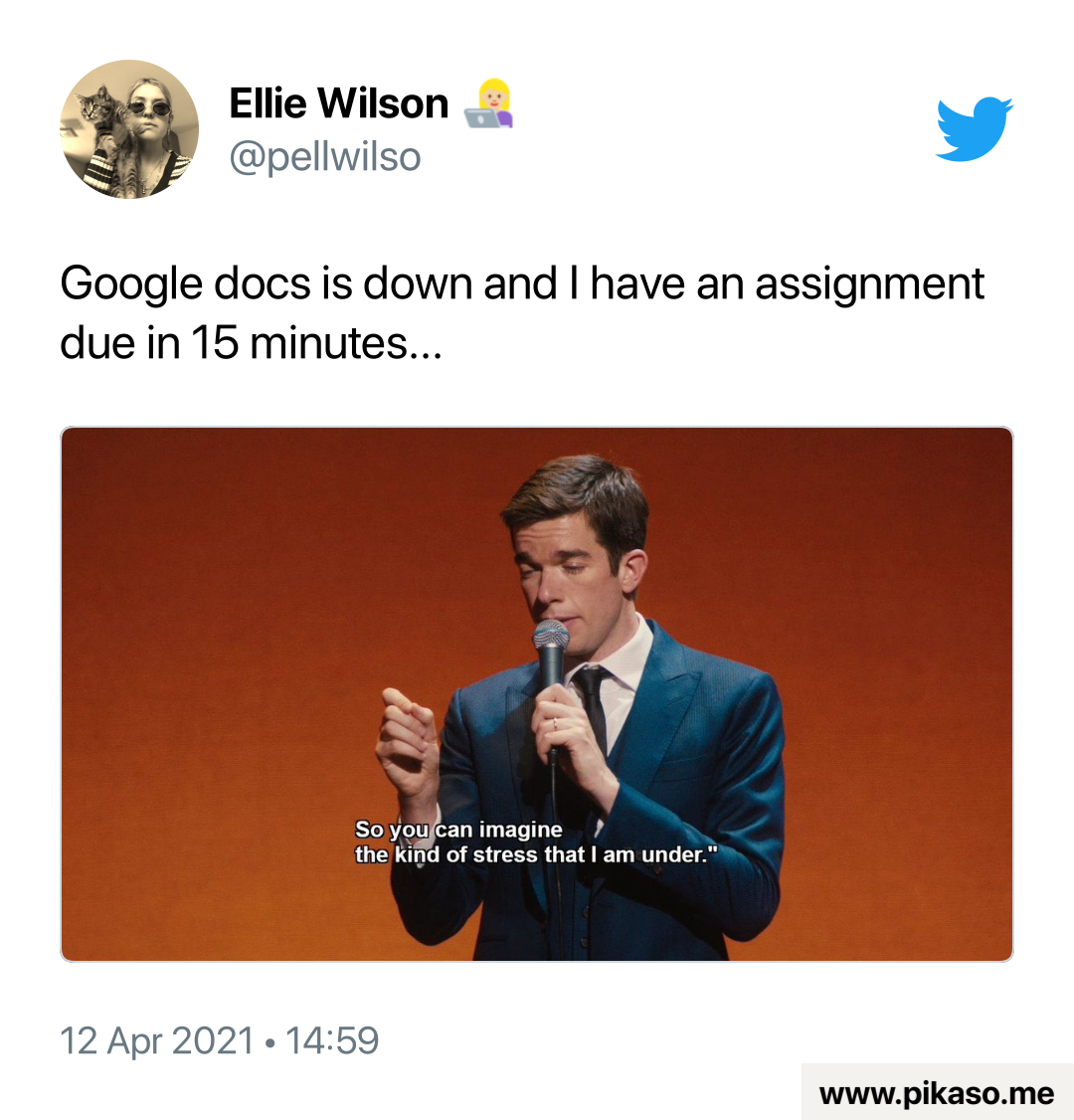
If you have a paper due for school or a presentation to give over Zoom, not being able to access your materials is pretty stressful, but at least being able to screenshot this should make it feel less like you’re claiming that the dog ate your homework.
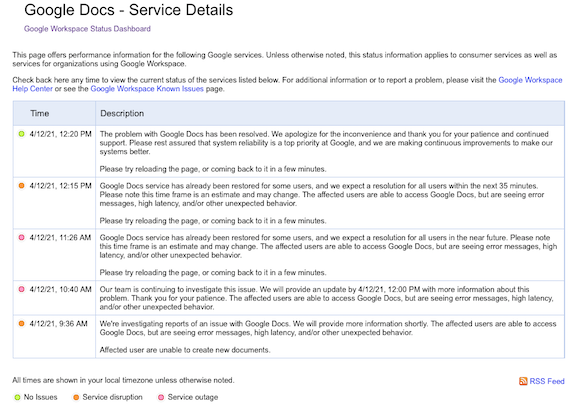
The Google Workspace Status Dashboard should be your first stop if you’re experiencing a kerfuffle with a Google product. The dashboard simultaneously reports the status of 18 regular Google products: Gmail, Calendar, Drive, Docs, Sheets, Slides, Sites, Groups, Hangouts, Chat, Meet, Vault, Currents (formerly Google+ for GSuite), Forms, Cloud Search, Keep, Tasks, and Voice, with a column for each of the past seven days and a status indicator for each day.
- Green indicates that there are no reported issues
- Orange indicates a service disruption
- Pink indicates an actual service outage (and no, I am not sure about the difference between a disruption and an outage)
Click on the dot and it opens a problem-specific page like the one above. At the bottom of the seven-day chart, you can select “older” to see more historical data.
In addition to the above products, the Google Workspace Status Dashboard also tracks the status of website management apps like Admin Console, Google Analytics, and App Maker, as well as Google Maps, Blogger, Google Sync for Mobile, and Classroom.
I encourage you to pick one of the solutions above, and the bookmark the URL on your computer and mobile devices. Next time you encounter difficulties getting to a site, verify that the problem is not on your end, check the status, and if you find that a site is down, move along to the next thing on your task list.
Divide and Conquer: Improve Productivity With Privacy Screens
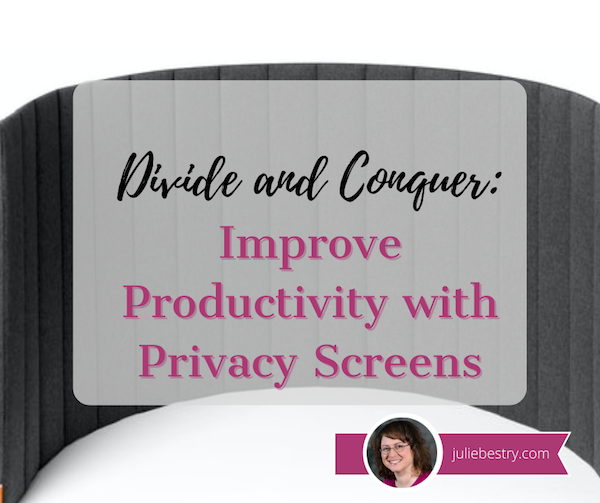
One of the most popular photos ever posted to the Paper Doll blog has been the Privacy Pop Bed Tent. Whether for a shared dorm room, children’s room, or any situation where you might want a little privacy – for sleeping, reading, meditating, or focus – a bed like this lets you place a divider between yourself and the world.
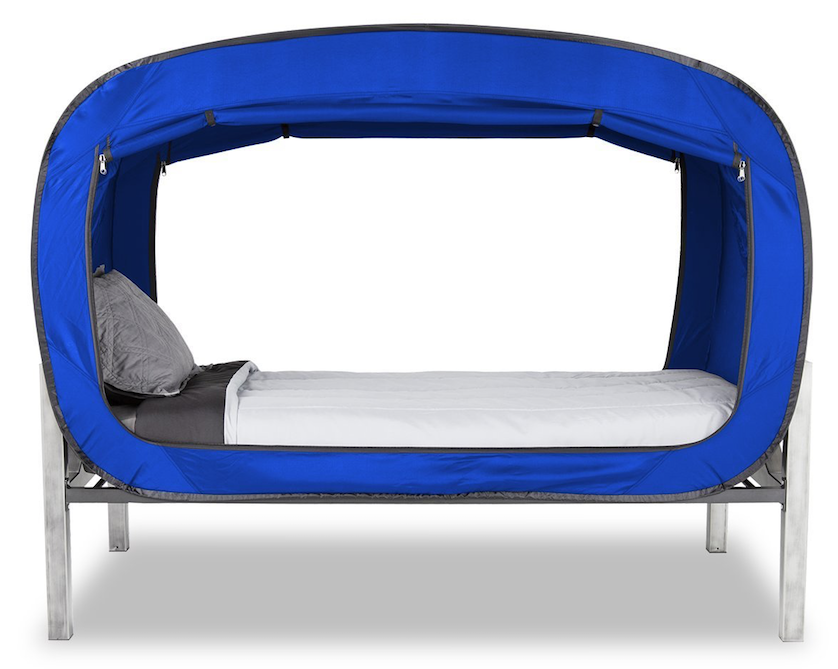
Organizing your space for privacy can yield much greater productivity.
A room or personal space divider can have the following advantages:
- Delineate a purpose for a space, motivating a stronger sense of purpose.
- Eliminate visual distractions for the user so you can maintain focus longer.
- Eliminate visual distractions for the audience during online classes, video chats, or during webinar presentations. (While virtual backgrounds can be useful, many computers are too old to run this digital solution.)
- Eliminate auditory distractions for the user.
- Dampen sounds for podcasts and audio/video production (if your dividers provide help with acoustics).
- Provide a sense of privacy from prying eyes. (If you aren’t worried about who is watching watching you, you can stay focused on your work.)
- Create a sense of ownership of one’s own space.
- Create a healthy barrier between oneself and others, particularly during flu season (and, obviously, as we are recovering from a global pandemic).
Recently, I’ve had a number of conversations with clients who are looking for better solutions for dividing their spaces.
Some have been working the better part of the pandemic from home with little to divide their own work space from that of their spouses or to divide grownup workspace from remote schooling space or play space from living space.
Others have been been struggling with a year-long, “Maaaahhhhhhhhm, she’s touching me!” lack of personal space among their kids.
Further, others are approaching a return to working in their offices and are dreading being distracted by their colleagues, anticipating having their focus, concentration, and privacy being threatened after a year of (somewhat) controlling the sensory inputs during work time.
And some are just freaked out about breathing around other people in an open workspace that, even during the best of times, ensured that they all got one another’s cold and flu germs.
Wouldn't you like to create your own private, dedicated workspace wherever you are? Click To TweetWouldn’t you like to create your own private, dedicated workspace wherever you are? Today, we’re going to look at a variety of options that can help you at home and work to give you more focus, a greater sense of privacy and a little more division between you and everyone else.
SET UP PERSONAL WORKSPACE DIVIDERS
The Poppin Dark Gray Portable Space Divider suits multiple circumstances where you might want a little privacy to accomplish your work:
- At desks or tables shared by multiple students (whether at home or at school)
- At a desk or table in your public or university library
- At a table in a coffee house or co-working venue
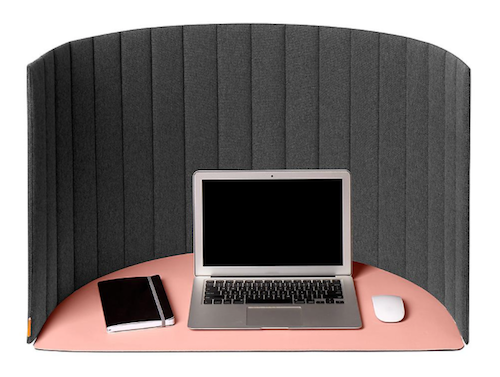
This sturdy 54″ wide by 20″ high divider unrolls and sets up to serve as a self-standing structure and says (politely), “This is my work area. All others, keep out! This means you!” letting you study, read, or work with efficiency and without distractions.
The Poppin Portable Space Divider is made of medium density fiberboard (MDF) and fabric. (MDF is an engineered wood product, manufactured by breaking down residual hardwood or softwood byproducts and turning them into wood fibres, mixing the fibers with wax and a resin to keep it bound. Then, by applying high temperature and pressure, MDF is turned into panels, which are generally more dense than plywood, so they’ll stand up sturdily.) Each of the 18 MDF panels is inserted as a slat in the dark grey fabric.
The divider is lightweight and and portable; just roll it up like a yoga mat, fasten the hook and loop closure, and carry it over your shoulder with the nylon carrying straps. No downward-facing dog required.
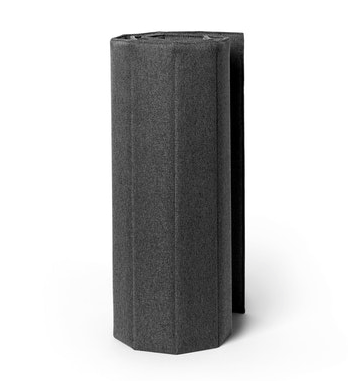 The Poppin Portable Space Divider is available for $59.99 at The Container Store
The Poppin Portable Space Divider is available for $59.99 at The Container Store. (Poppin has also created Curved Desk Pads
in grey, slate blue, and blush to partner with the Portable Space Dividers. They are also available from The Container Store, for $19.99.)
If you own (or work in) an open office, you might be looking for something a little more upscale to give returning employees something to help them maintain focus. eScape Desk Screens come in a wide variety of colors (including Sky Blue, Green, Emerald Green, Orange-Yellow, Orange, Red, Purple-Red, Purple, Blue, Dark Blue, and for some versions, Silver Grey, White, and Sesame Black) and mounting styles.
The eSCAPE Edge Clamp with Knob Acoustical Desk Divider 12″ high version is made of colorful, 12 mm-thick, round-edged, acoustic tiles made from recycled plastic (PET) bottles. Five width options are available (23″, 35″, 47″, 59″ and 71″) and they are attached to desk surfaces with a knobbed clamps (two for the three smaller sizes, and three clamps for the two larger versions):
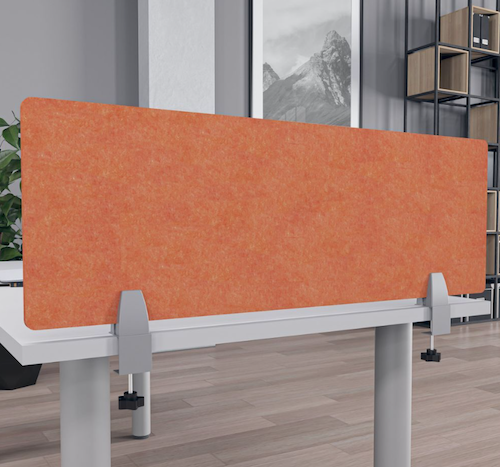
The 16″ high (shown below) and 24″ high versions offers the same colors, features, and options, but more privacy:
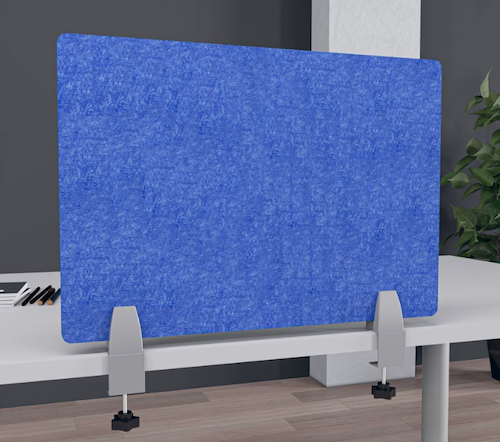 The clamped versions are sold by Skutchi for $133.39.
The clamped versions are sold by Skutchi for $133.39.
If you’d prefer a free-standing version of the eScape Desk Dividers, Skutchi also sells those.
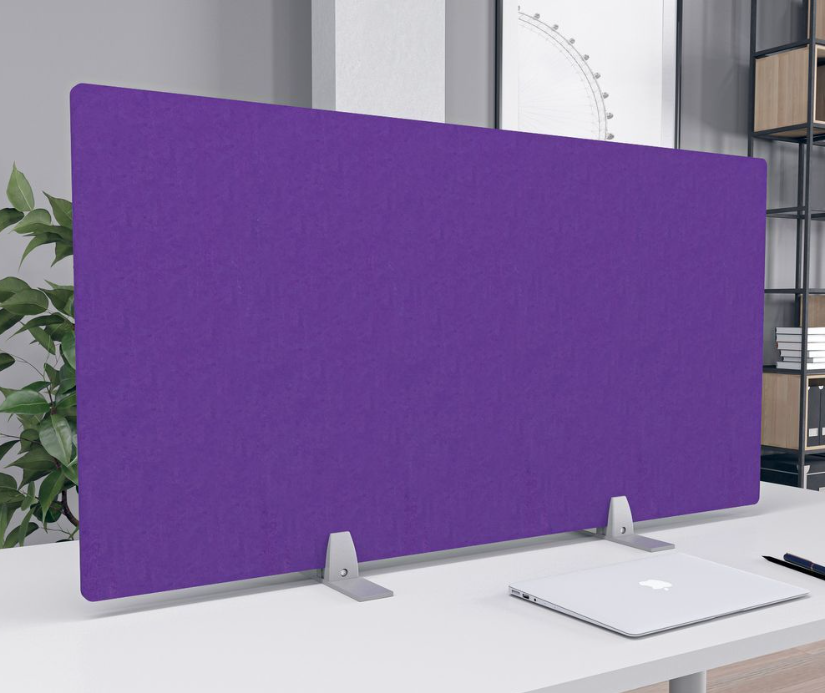
You’ll lose a quite a bit of desktop real estate to make room for the mounts, but you’ll save a bit of money, as the 12″, 18″, and 24″ high options (all with the same width, color, and feature options of the clamped versions) sell for $96.59.
Skutchi’s dividers are custom-made and available with free shipping.
Given everything that’s happened over the past year, you may be considering getting some kind of sneeze-guard to surround your work area or classroom space (for yourself, your children, or for the school in which you teach). These come at a wide variety of price points and aesthetic levels, from Applied Ergonomics’ fold-flat, polycarbonate school hygiene barriers, $299 a ten-pack:
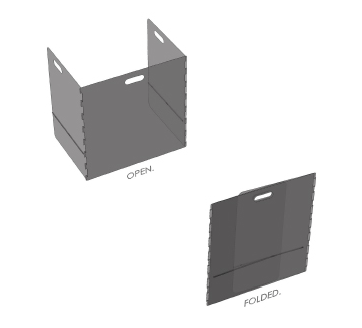
to Mergework’s Terrace and Enclave Sneeze Guard Workspace Social Distancing solutions with multiple mounting options at fancy-pants pricing.
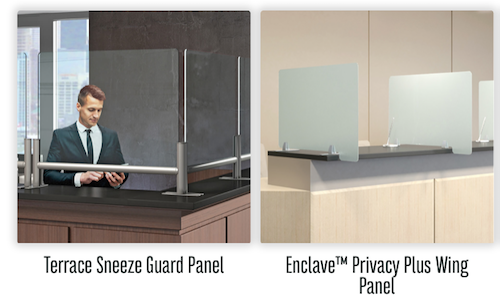
If you’ve ever worked in an office with cubicles, you know that the absence of a door can have impact on privacy. (To be honest, so does the absence of a ceiling, but unless you move that Privacy Pop Bed Tent into your cube, I’ve got nothing for you.) If you’ll be returning cube setup, your HR department might be interested in this rolling Quartet Workstation Privacy Screen to improve productivity (and morale).
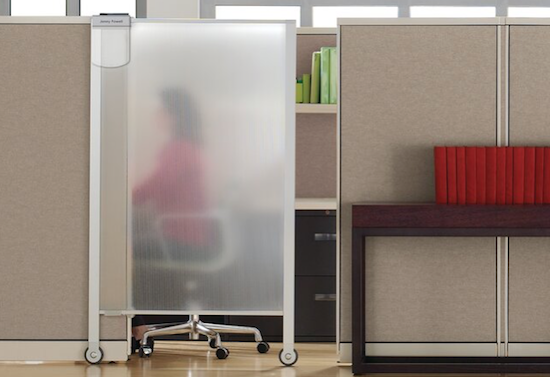
The translucent, shatterproof privacy screen measures 38″ wide by 64″ high. The frame is aluminum, while the screen itself is polycarbonate, making the unit durable and lightweight. As-is, the screen can roll into place for cublicles up to 65″ tall, and there are leg extenders included for cubicles taller than 68″.
There’s even an attached whiteboard with a nameplate so you can tell colleagues when you’ll be available and let them leave messages for you.
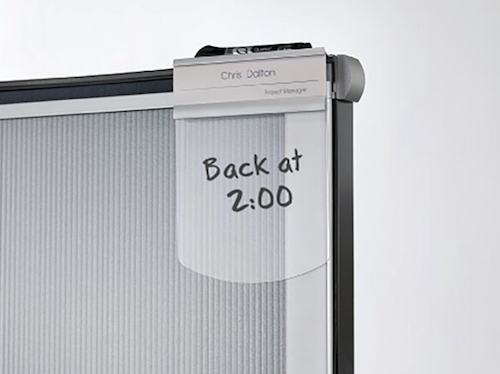
The Quartet Workstation Privacy Screen is available from Staples, Quill, Granger, Amazon, and Walmart. Currently, the price ranges significantly, from $261 to $390, and is the least costly at Walmart and Amazon. (There is also a sliding, non-wheeled version, measuring 36″ wide by 48″ high, which slides into cubicle walls and is not wheeled; it runs about $205.)
USE ROOM DIVIDERS TO CREATE WORK ZONES
Sometimes, you need a divider of greater size and scope. Over the years, I enjoyed being interviewed online, like the eight shows I did for Smead‘s Keeping You Organized video podcast:
Secrets to Organizing a Small Business
Fears That Keep You From Getting Organized
Paper vs. Digital Organizing (Part 1)
Paper vs. Digital Organizing (Part 2)
How to Get Organized When You Have an Extended or Chronic Illness (Part 1)
How to Get Organized When You Have an Extended or Chronic Illness (Part 2)
Essential Lists for Organized Travel (Part 1)
Essential Lists for Organized Travel (Part 2)
The problem? Behind my office is another room that is not appropriate as a professional video backdrop. Until 2019, as a stop-gap measure, whenever I made these kind of videos, I’d turn my desktop computer toward the opposite wall and move my chair; however, the overhead lighting against this background made spidery shadows above and around my head. I felt like a true Not-Ready-For-Prime-Time Player.
About eighteen months ago, when participating in Ray Sidney-Smith’s Productivity Summit 2019, I needed a better solution. My plan was to try to get a pretty room divider, something along the lines of the gorgeous Japanese shoji screens one often sees in movies — light wood, rice paper, hinged panels. Something like this, from Wayfair:
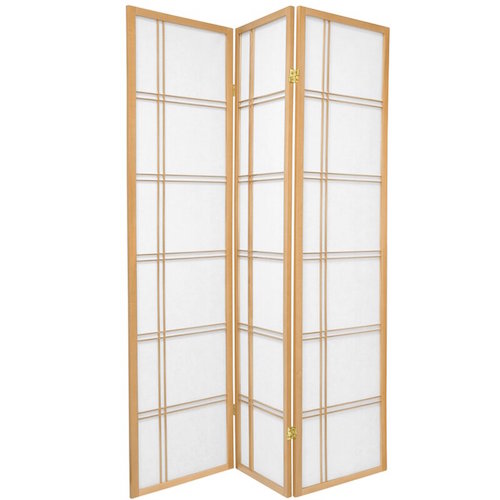
However, I was hoping for something a little less expensive than the (reasonable) $169 that this one goes for, and one available on a little speedier delivery schedule. Unable to find an appropriate screen locally, and with only a few days to go until the summit, my colleague Maria White suggested that I try Ollie’s, a factory close-out store.
There, for a decidedly more pleasing $38, I got a rattan, indoor-outdoor, hinged divider that, on video, looks far more elegant than it does up-close. If you have seen me on any recent webinars or video podcasts, you’ve seen it (and more importantly, you haven’t seen the room behind my office).
For a taste, you can peek at two recent Anything But Idle episodes I did with hosts Ray Sidney-Smith and Augusto Pinaud, focused on women experts on productivity, organizing, and technology. There’s March 8th’s where I was a solo guest panelist, as well as March 15th’s (below), where I shared the spotlight with the always-glorious, brilliant, and charming Deb Lee:
(If you make it all the way through, see if you can find where I almost devolve into a fit of giggles.)
For what it’s worth, if you do want any of a variety of hinged screens, upscale or downscale, two good shopping options are these at Wayfair and the sumptuous designs at RoomDividers.com, including their shoji screens, art prints, office partitions, and other room dividers, like this 6-foot double-sided, Lavendar Road canvas print for $149:

In researching this post, I occasionally found intriguing room dividers that do double-duty. For example, this RHF 5 1/2-foot tall, four-panel privacy screen at Amazon doubles as a corkboard message board and costs only $119.99.
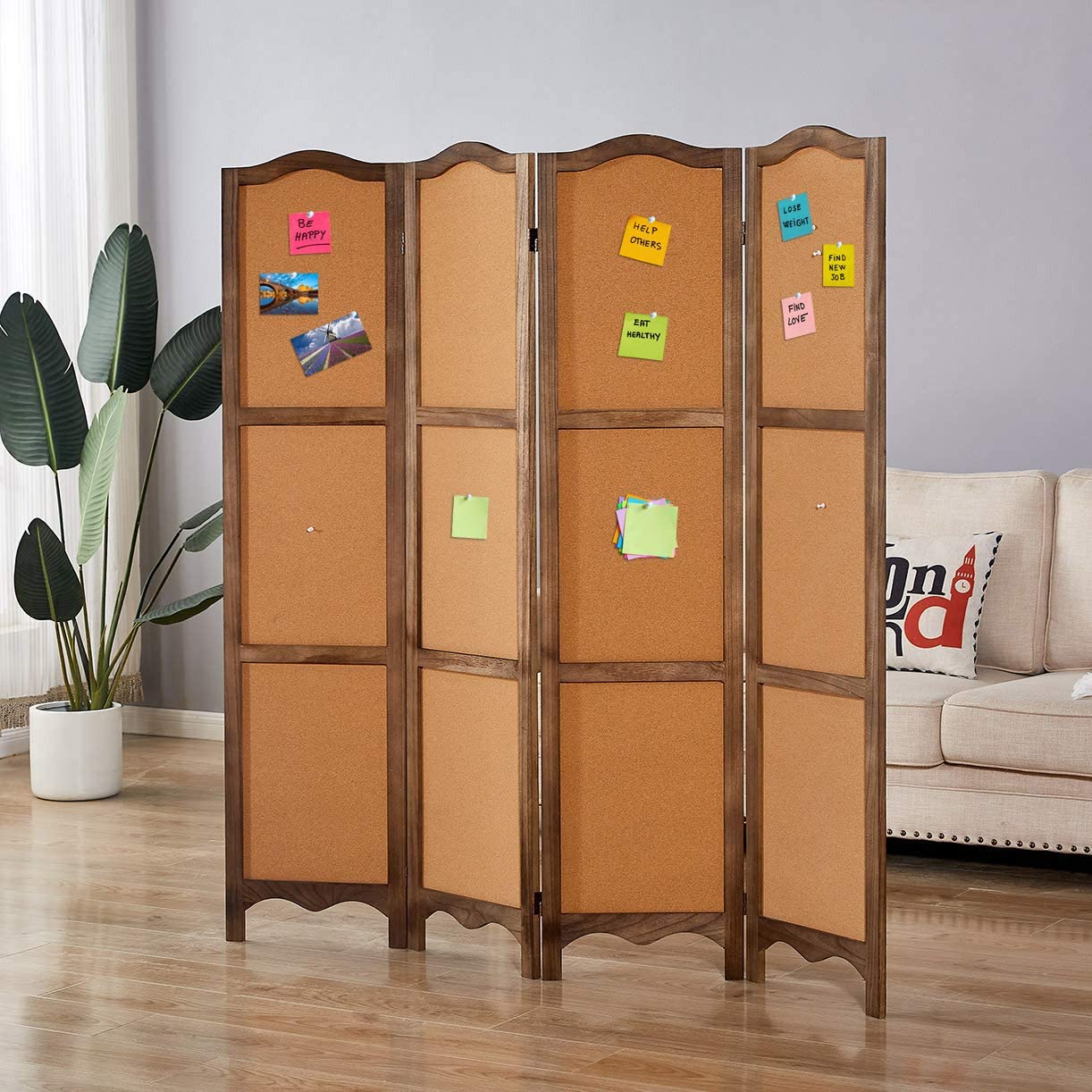
It’s not necessary to purchase special furniture simply to divide a room to provide more focus on each space’s individual purpose.
For example, if you already have a free-standing bookshelf, around five-feet tall or higher, like the Ikea Kallax shelves, you can easily divide a room into sections merely by placing the bookshelf between your two spaces, making a sleeping area and study space, or office and workout area. Check out Apartment Therapy’s The Best Bookcase Room Dividers to get some inspiration.
CONSIDER SPECIALITY DIVIDERS FOR YOUR SPECIAL NEEDS
Of course, sometimes, you will want specialized furniture.
Imagine you’re building a career as a podcaster but you’re a renter and can’t affix acoustic tiles to the wall to create an audio studio. And let’s say you don’t have a walk-in closet loaded with a wardrobe of clothes to muffle the sound. You might opt for the Versare Versipanel Flexible Sound Control Partition Wall, sold by Walmart for $819.
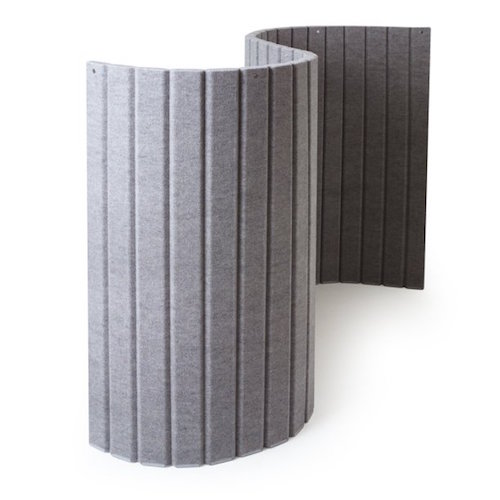
The Versipanel is designed to be an attractive, sound-absorbent, wall enhancement. It’s 8 feet wide by 6 1/2 feet high, comes in blue, black, and grey, and is one single fabric panel with flexible segments.
Rather than being positioned straight-up, like most room dividers, the panel is meant to be positioned with some curve in it in order to stand up & be stable on its own. (For a larger divider, multiple units can be connected end-to-end with the pre-installed heavy-duty magnets.)
Store the Versipanel flat against the wall, or (like a VERY LARGE yoga mat), it can be rolled up and carried away to storage.
If you offer specialized teaching services for tiny humans, whether at a child care center, private school, or tutoring service, you might have a reason to invest in a more serious set-up. Discount School Supply has a wide variety of room dividers, from their Big Screen Right Angle Panels (for $185):
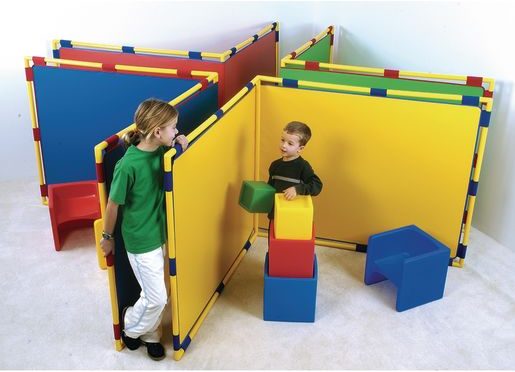
to their line of Big Screen Right Angle Panels mini-classrooms (sure to muffle sounds and improve focus) for $586.87.
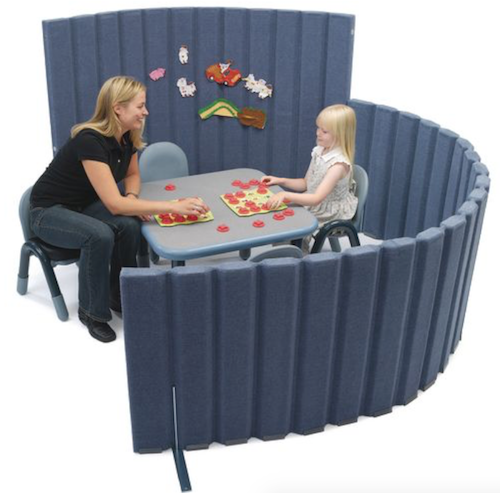
FIND YOUR IDEAL DIVIDER
This post is just a sample of your options for organizing by dividing your space, creating zones, giving you privacy, and eliminating distractions. It’s meant to give you a taste of the possibilities available rather than a complete resource. Depending on your physical needs, budget, and the size of your space, you may want to use the following search terms to locate the right dividers for you:
- Room Dividers
- Privacy Panels
- Modesty Panels
- Hygiene Barriers
- Anti-Microbial Barriers
- Acoustic Dividers
THE ULTIMATE IN PRIVACY
If none of these ideas provide you with the level of privacy you need, especially in the workplace, there is one option short of sealing yourself up at home and pretending you’re still on lockdown, though it may be difficult to get your company onboard with the costs.
Poppin has a line of office “phone booths” that gives you a safe, quiet office within your office. The PoppinPod Om Sit and PoppinPod Om Stand, both for $5499, are made of high-grade glass and steel, and give you the privacy to focus, make confidential telephone calls, and isolate yourself from that office mate who does that thing. (You know what it is. Let’s not spell it out.)
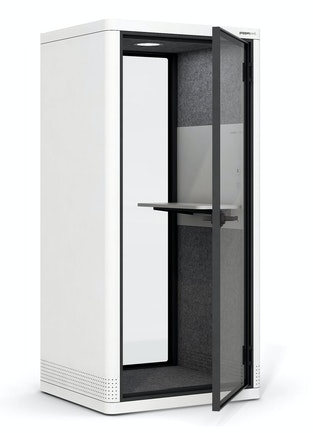
Both of the PoppinPod Om versions come in black or white, have USB chargers and a motion-activated light and fan, and feature dark grey, sound-absorbing PET lining. They’re shipped and delivered fully-assembled, because apparently the Poppin people have seen us trying to assemble Ikea furniture and don’t want to embarrass us.
For fancier workspaces, or if you’re hoping to have a work partner with you but still divide yourselves from your colleagues, the PoppinPod Kolo series upgrades from the Om experience and can accommodate 2, 4, or 6 individuals at prices ranging from $7000-$30,000.
And let’s face it, this is as close to Doctor Who‘s TARDIS as we’re ever going to get.


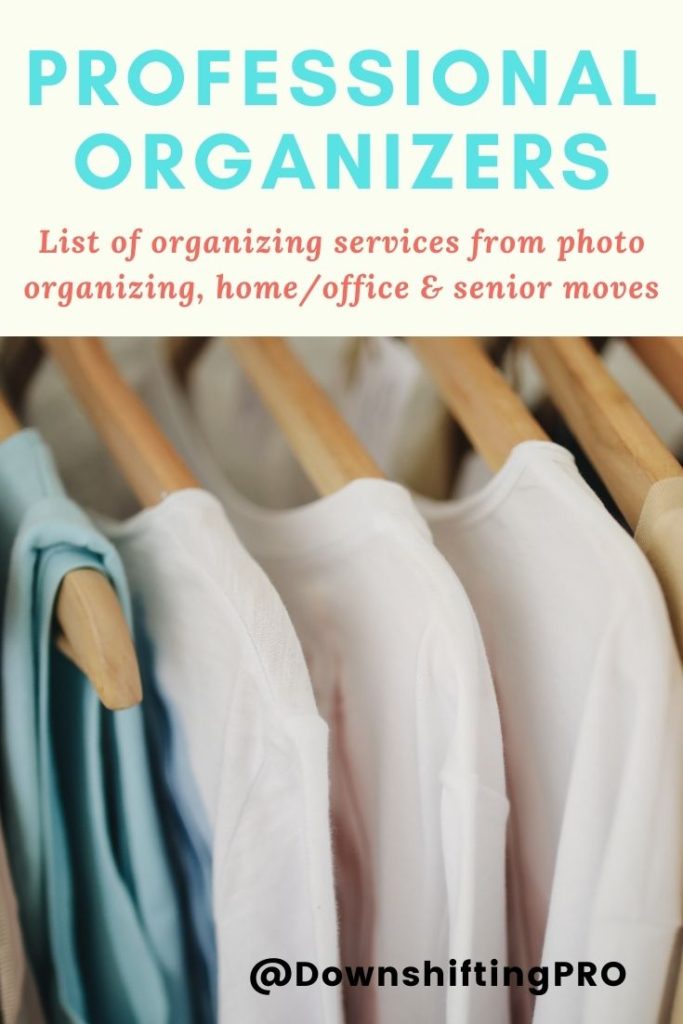
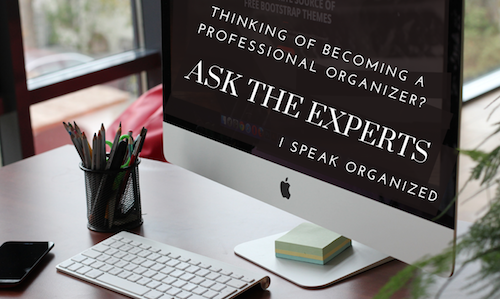
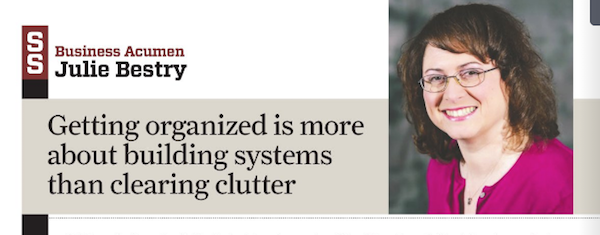
.png) Please include attribution to https://www.gini.co/ with this graphic.
Please include attribution to https://www.gini.co/ with this graphic.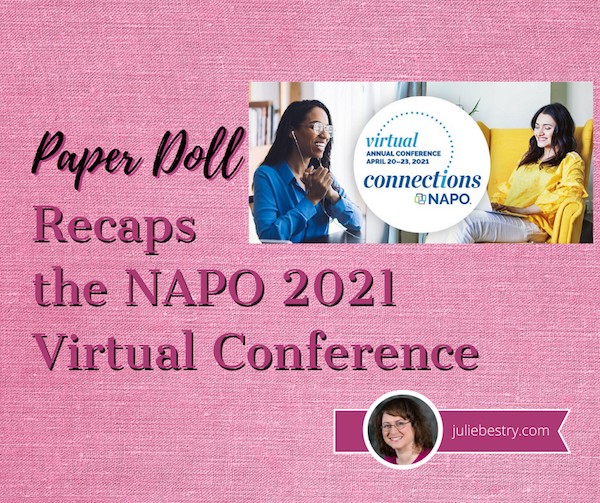

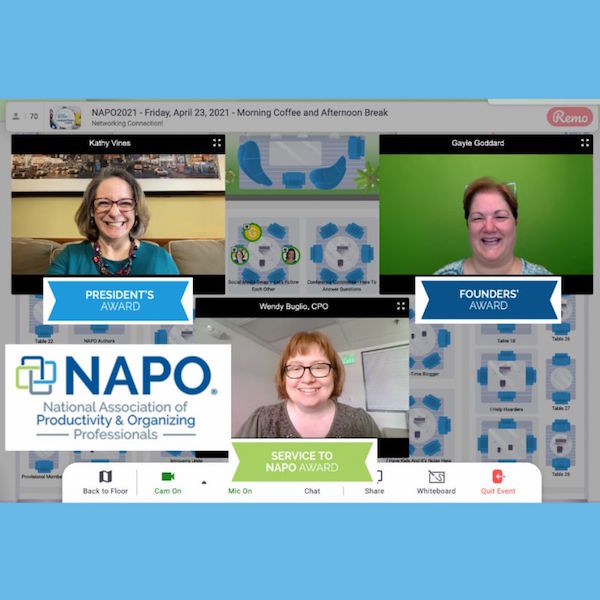



Follow Me